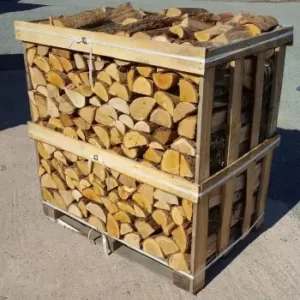10 Common Firewood Myths Debunked
When it comes to burning firewood, there are plenty of myths and misconceptions that can lead to inefficient fires, wasted wood, and even dangerous situations. Let’s clear up the confusion by debunking the top 10 firewood myths.
Table of Contents
- Myth 1: All Wood Burns the Same
- Myth 2: Green Wood is Just as Good as Seasoned Wood
- Myth 3: Softwoods are Bad for Firewood
- Myth 4: The Bigger the Log, the Better the Burn
- Myth 5: Firewood Should be Stacked Against Your House
- Myth 6: Painted or Treated Wood is Safe to Burn
- Myth 7: Burning Paper and Cardboard is Harmless
- Myth 8: You Don’t Need to Clean Your Chimney if You Burn Hot Fires
- Myth 9: Driftwood is Perfect for Firewood
- Myth 10: Wood-Burning Stoves and Fireplaces are Inefficient
Myth 1: All Wood Burns the Same
Reality: Not all firewood burns equally. Different woods produce different heat levels, burn times, and even smells. Hardwoods like oak, maple, and hickory burn hotter and longer, while softwoods like pine ignite quickly but burn faster and cooler. Choosing the right wood depends on your heating needs and the type of fire you want.
Myth 2: Green Wood is Just as Good as Seasoned Wood
Reality: Green wood, or freshly cut wood, contains a high moisture content, making it difficult to burn and causing excess smoke and creosote buildup. Seasoned wood, on the other hand, has been dried for at least 6-12 months, reaching a moisture content below 20%, which makes it burn cleaner and more efficiently.
Myth 3: Softwoods are Bad for Firewood
Reality: Softwoods, such as pine and spruce, get a bad reputation because they tend to produce more creosote when burned green. However, when properly seasoned, softwoods can make excellent kindling because they ignite quickly, helping to start fires easily. For sustained heating, hardwoods are still preferred, but softwoods can play a valuable role.Firewood Myths
Myth 4: The Bigger the Log, the Better the Burn
Reality: Large logs burn longer but are harder to ignite and may produce less heat initially. Smaller, split logs burn hotter and faster, making them ideal for generating heat quickly. A mix of larger and smaller pieces can create a more consistent, efficient fire.
Myth 5: Firewood Should be Stacked Against Your House
Reality: Stacking firewood directly against your home might seem convenient, but it attracts pests like termites, ants, and rodents, which can then find their way into your home. Instead, stack firewood on a rack or pallets at least a few feet away from your house with good airflow to help keep it dry.Firewood Myths
 Myth 6: Painted or Treated Wood is Safe to Burn
Myth 6: Painted or Treated Wood is Safe to Burn
Reality: Burning painted or treated wood releases toxic chemicals into the air, posing a risk to your health and creating potentially hazardous fumes. Always stick to natural, untreated wood for burning to avoid dangerous pollutants.
Myth 7: Burning Paper and Cardboard is Harmless
Reality: While paper and cardboard can help get a fire started, burning them in large amounts releases toxic chemicals, especially if they contain inks or coatings. Use them sparingly and avoid glossy or colored paper. For safety, it’s best to stick with natural firestarters like kindling or softwood splits.
Myth 8: You Don’t Need to Clean Your Chimney if You Burn Hot Fires
Reality: Even with hot fires, creosote can still accumulate in your chimney, posing a risk of chimney fires. Regular chimney cleaning and inspection by a professional are necessary, even if you burn hot, clean fires. It’s recommended to clean your chimney at least once a year, especially if you burn wood frequently.
Myth 9: Driftwood is Perfect for Firewood
Reality: Driftwood might seem like a convenient option, but it’s not ideal for burning. It often contains salts and minerals from seawater, which can corrode metal stoves and chimneys and release toxic fumes. Instead, use driftwood for decorative purposes or dispose of it safely.
Myth 10: Wood-Burning Stoves and Fireplaces are Inefficient
Reality: Modern wood-burning stoves and high-efficiency fireplaces are designed to burn wood more completely and cleanly than traditional open fireplaces. They offer better heat output and lower emissions, making them a great option for sustainable home heating.Firewood Myths
Final Thoughts
Understanding the truth behind these common firewood myths can help you burn wood more safely, efficiently, and enjoyably. By following proper techniques and choosing the right type of wood, you can keep your home warm and cozy all winter long.
